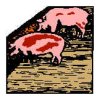

To send a message to an author, click on the author's name at the end of the article.
This Month in Ag Connection | Ag Connection - Other Issues Online]

Distillers’ grains are a by-product of the alcohol manufacturing industry. The recent construction of an ethanol plant in Macon, Missouri, has made distiller grains a more economical feed alternative for livestock.
During the alcohol production process, live yeast culture, enzymes and other additives are mixed with milled corn or other high quality grains. This mixture, along with water, is sealed in an airtight vessel and allowed to ferment. After the fermentation process is complete, the solids are screened from the liquid. The liquid fraction is distilled to produce alcohol. The solid fraction is pressed to remove the excess moisture and is then dried and ground to produce distillers’ dried grains (DDG). After the alcohol has been removed from the liquid fraction, the remaining is evaporated to concentrate the soluble material into condensed distillers’ solubles (20 to 40 % dry matter) or dried and ground to create dried distillers' solubles (DDS). Dried distillers’ solubles (DDS) is usually mixed with the DDG to form distillers’ dried grains with solubles (DDGS).
Nutritional ProfileDistillers' grains are quite low in lysine content (0.6-0.9%). Swine diets containing distillers' dried grain with solubles (DDGS) need to be formulated on a digestible lysine and energy basis. Formulating the diet on a crude protein basis will result in a lysine deficiency along with a potential deficiency of other amino acids like tryptophan, methionine or threonine. These deficiencies can reduce growth performance.
Growth Performance
Researchers have reported no differences or slight improvements in growth and feed
efficiency of young pigs fed low concentrations (2.5-5%) of DDGS. In grow-finish diets,
DDGS should not exceed 20% of the diet dry matter. If grow-finish diets are formulated
using a 20% DDGS, synthetic lysine and tryptophan should be used to balance the amino
acids. It is generally recommended to limit the inclusion rate of DDGS to 10% in
grow-finish diets.
The breeding herd diet is probably the best place to use DDGS with a maximum inclusion rate of 40% in gestation diets. The use of either distillers’ dried solubles (DDS) or distillers’ dried grains (DDG) in swine diets is not recommended. The quality of the protein and ratio of amino acids does not support growth performance.
Economics
In Table 1, the economic value of DDGS in grow-finish diets is shown and the assumption is
made that the diets are formulated to contain only a 10% inclusion rate of DDGS. If a 20%
inclusion rate is used, you may assume a 3% reduction in growth performance, thus
decreasing the DDGS value by $24/ton.
| Corn Price($/bushel) |
Soybean meal Price($/ton) | |||
|---|---|---|---|---|
| 150 | 200 | 250 | 300 | |
| 2.00 | 81 | 84 | 87 | 89 |
| 2.50 | 98 | 100 | 103 | 106 |
| 3.00 | 114 | 117 | 120 | 123 |
| 3.50 | 131 | 134 | 137 | 139 |
| 4.00 | 148 | 150 | 153 | 156 |
Conclusion
Distillers’ dried grains with solubles can be efficiently used in swine diets;
however, dietary formulations should be evaluated by a nutritionist before
implementation to ensure growth performance is maintained. The DDGS should be
analyzed before formulation because considerable variation between sources may exist.
Distillers’ by-products do have a distinct "malt" odor and a bitter taste. High inclusion
rates above the ideal recommendation of 5% for nursery, 10% for grow-finish, and 40%
for gestation diets may cause feed refusal and necessitate the addition of a flavor or
masking agent to the feed. At the higher inclusion rates, the supplementation of several
synthetic amino acids will increase the total dietary cost.
(Author: Marcia S. Carlson, State Swine Nutrition Specialist)
This Month in Ag Connection | Ag Connection - Other Issues Online]

The Environmental Protection Agency (EPA) is in the process of updating water quality regulations that address nonpoint water quality concerns in lakes and streams. This effort includes initiatives to:
Confined animal feeding operations are a primary target of the new regulatory effort – this section is known as the USDA/EPA Unified AFO (animal feeding operation) Strategy. Crop farmers can be affected by the new regulatory efforts if their operation is within a watershed listed as impaired by nitrogen and/or phosphorus.
The following should be helpful in sorting through these water quality initiatives:
National Water Quality Inventory
The EPA Office of Water submits a report to Congress every 2 years on the water quality of
US lakes and streams. The National Water Quality Inventory: 1998 Report to Congress
was released in late June 2000. Overall conclusions of the report are similar to the 1996
report. The report contends that up to 40% of US surface waters are impaired to the point
of not supporting swimming and fishing. Leading pollutants were silt, bacteria, nutrients
and metals. Runoff from agricultural land (nonpoint source pollution) is cited as the
leading contributor to water quality impairment. The report suggests agricultural runoff
impairs water quality in 20% of the surveyed rivers and streams, along with 14% of the
surveyed lakes. Click here to
access the full report.
Permitting and Effluent Guidelines
The EPA is drafting new CAFO regulations, which are to be released in December 2000 for
public comment. The final regulations are scheduled for implementation within 2 years
after release of the draft. Issues likely to be addressed in the new rules include:
This process has the potential to dramatically affect Missouri CAFO regulations. The major impact would be that all livestock operations, regardless of size or livestock species, could be required to have comprehensive nutrient management plans (CNMP). Livestock raised on pasture with greater that 50 % vegetative cover and most livestock pens used for temporarily holding livestock for auction or slaughter would be exempt from maintaining a CNMP.
New Water Quality Standards for Nitrogen and Phosphorous
There are already water quality standards for dissolved oxygen, ammonia, metals, pH,
temperature and other parameters. This new initiative would expand the standards to
include total N and P concentrations, chlorophyll concentration and a turbidity standard
(water clarity). States would then set these new water quality limits for all streams and
lakes over the next 2 to 3 years.
Total Maximum Daily Load (TMDL's)
The TMDL process to establish nonpoint limits in impaired watersheds was published in the
federal register by the EPA on July 13, 2000, but would not be implemented until Oct. 1,
2001 as a result of Congressional action. A TMDL plan would be developed in every impaired
watershed to establish the reductions in nutrient load needed to correct the identified
water quality problem, practices that would be used to attain the target reductions in
nutrients, and the time table for implementing the plan. The new TMDL process would
address point and nonpoint pollution sources.
Draft Action Plan for Reducing, Mitigating, and Controlling Hypoxia in the Northern Gulf of Mexico
The EPA is participating in a process to address the "dead zone" in the Gulf of
Mexico. The draft plan calls for a 20 to 40% reduction in the nitrogen load reaching the
Gulf from the Mississippi River watershed. Click here to view the draft
action plan on the Internet.
It should be noted that this is a summary of what is currently being proposed by the EPA and state environmental agencies. While sections of the efforts highlighted above may not become federal or state regulation, agriculture producers of both crops and livestock should take notice that environmental stewardship and protection will become a larger part of the future farming operation.
(Author: Darin Starr, Ag. Engineering Specialist)
This Month in Ag Connection | Ag Connection - Other Issues Online]

Tax Issues – Hedging And Speculation
Given this year’s low cash grain prices, the availability
of LDP, and the shortage/cost of storage, many farmer/producers may be considering
marketing strategies that involve selling cash grain and re-owning "paper
grain". The most common types of "paper grain" are futures and options. It
is important for farmer/producers to understand the tax consequences for this type of
marketing strategy.
First consider the basic differences between speculation and hedging. Hedging transactions can take place at any time the farmer/producer has the commodity under production, has it on hand for sale, or reasonably expects to have it on hand.
Entering into market transactions (long or short/buying first or selling first) with the motive of making money on the rise or fall of the market price –is speculating. Selling cash grain and re-owning "paper grain" is often considered by producers and market advisors to be a risk management strategy. However, since the producer re-owns the "paper grain" in anticipation of capturing higher prices, the purchase transaction is considered by IRS to be speculative.
On the other hand, if anyone enters into the futures or options market taking an opposite position they have outside the market – the gain or loss in the futures or options market offsets the gain or loss in the physical commodity held outside the market. Thus, this type of futures or options strategy is entered into for the purpose of price insurance (hedging), not price speculation. For example, a producer growing or storing grain could sell futures to hedge the expected price, lift the hedge as price falls and later sell futures again as prices fluctuate higher – re-establishing the hedge. As long as the transactions are offset by a cash market position, the transactions are considered hedges.
The tax consequences between a hedge and speculation vary significantly. Futures and option transactions that are not hedging transactions generally result in a capital gain or loss. These capital gains and losses are generally reported on Schedule D and the maximum net capital loss deduction per year is $3000.
The gain or loss on farm commodity hedging is generally an ordinary gain or loss and reported on Schedule F. There is no annual maximum loss deduction relative to hedging transactions reported on Schedule F.
(Authors: Parman R. Green and Melvin Brees, University Outreach/Extension Farm Business Management Specialists)
This Month in Ag Connection | Ag Connection - Other Issues Online]
Tim Schnakenberg has joined the Central Missouri Agriculture Staff as Agronomy Specialist in Morgan County. Tim moved to Central Missouri from Southeast Missouri where he was an Agronomy Specialist for nine years.Todd Lorenz has joined the Central Missouri Agriculture Staff as Horticulture/Agronomy Specialist in Cooper County. Todd has been working as a Research Specialist at Sanborn Field for the last nine years.
This Month in Ag Connection | Ag Connection - Other Issues Online]
Publishing Information
Ag Connection is published monthly for Northeast and Central areas of Missouri producers and is supported by the University of Missouri Extension, the Missouri Agricultural Experiment Station, and the MU College of Agriculture, Food and Natural Resources. Managing Editor: Mary Sobba.